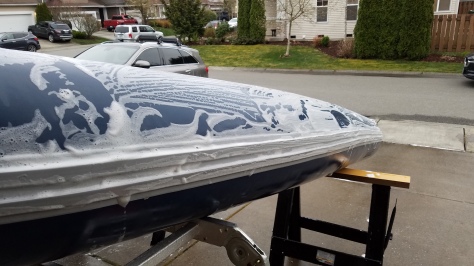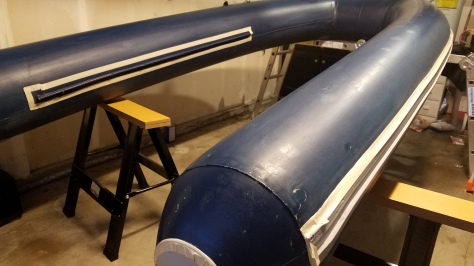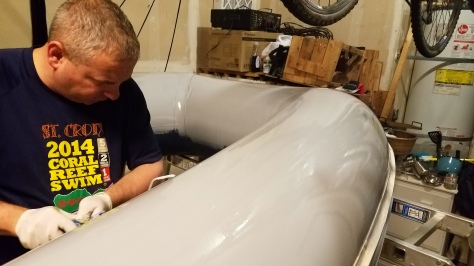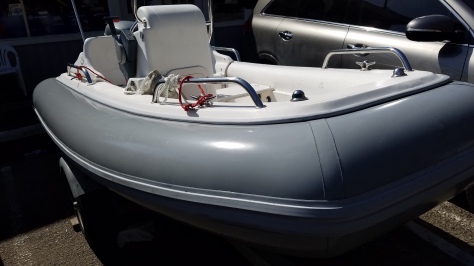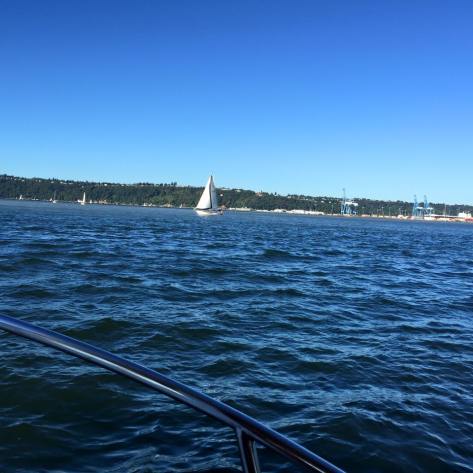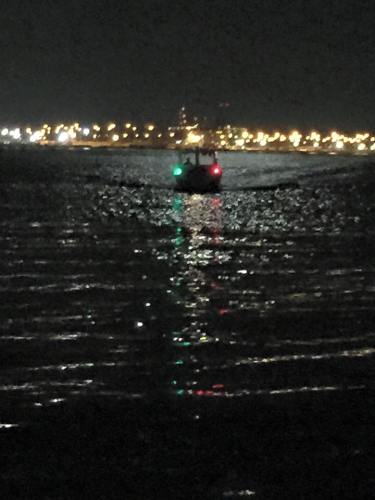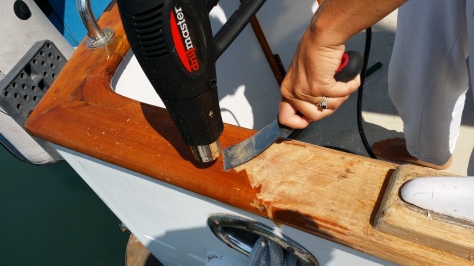We went on our first boat trip of the year. We left our home dock on Friday, April 24th, and tied up to the docks at the Port of Poulsbo that afternoon. On Saturday I presented to the Cascadia sailors also in attendance, discussing Building your own Chartplotter with AIS, Radar, and followed up by listening in to presentations on sailing much further north than we have tried — all the way up to Alaska in most cases. On Sunday, April 26th, we returned home, this time going around the east side of Vashon Island to avoid the currents, tying up at home in the mid-afternoon hours.
The map below shows the path as captured by our GPS location on our OpenCPN chartplotter with the purple track being the north-bound trip, and the yellow track being the south-bound return trip. There are a few gaps where I rebooted the machine for some reason or another, but it still shows the path we took quite well. I just extracted the route from OpenCPN, and used gpsvisualizer.com to generate KML files from them. Then I logged into Google Maps, and imported the KML files into a custom public map.
Preparation
Prior to the trip there was a ton of work to do.
Last summer we had a bit of an electrical issue on board, and lost our alternator and house bank of batteries. While we had replaced all the batteries, and purchased and mounted a new alternator, it wasn’t hooked up properly. I couldn’t figure it out as the wiring did not match up to any of the diagrams on the instructions that came with it. So before we went on this trip, I wanted to have a professional marine electrician finish up the installation.
I improvised a charging solution so that the engine wouldn’t die on the way, and drove the boat over to ModuTech Marine. At first even the electrician was confused as to what the instructions were showing. But he then discovered the issue: The instructions were showing three completely different options for installing the alternator. They just didn’t actually state that they were options, so I was trying to do all three at once! Less than an hour later we were done, and spent a couple hours cruising around Commencement Bay, validating that the batteries were, in fact, being charged properly.
Mechanically the boat was ready to go. Since this was the first time the boat had been running for any considerable time since last August, it was nice to just be out on the water.

I also had to prepare for the presentation I was giving. I have been working on running OpenCPN on these low-powered systems such as the Raspberry Pi and CubieTruck for quite some time, but because these are active projects and platforms things change. Taking the opportunity, I started over from scratch, building the chartplotter on a Raspberry Pi 2, the most recent device. Over a couple days’ span, I had built a new system, running the most recent version of OpenCPN (4.1.412), with GPS location.
I also had an AIS receiver module that I planned on hooking up while we were underway and within range of signals. I also threw together a Powerpoint slide deck for the presentation, plus a bunch of other examples of hardware. The presentation was ready as well!
The Trip North
The trip north started out under overcast skies. We got a bit of a later start than originally planned, but did get some extra water in the tanks, and we were still well within the timeframe to catch the ebb current to assist our way north. We cruised through Colvos Passage at nearly 8 kts over ground, 6 through the water, with a substantial front to the south following us all the way.
The conditions were nice enough, though, that I was able to have a few hours to play with the AIS module, and caught our first ever AIS contact just as we were coming out of Colvos. It was a ferry leaving the Southworth Docks, and it showed up great! I wasn’t sure how to take a screenshot, so I simply took a picture with my phone:

Once we got to the north end of Blake Island, that front that was chasing us caught up. 2-3′ chop built up, and the ride got quite bumpy, right as we were entering into Rich Passage. Of course the Bremerton Ferry heading in at the same time didn’t do anything to reduce the stress of the situation. But once we rounded the southwest corner of Bainbridge island and turned more north, the wind pushed us straight into Liberty Bay. It was still windy and bumpy, but much better. The boat handles these conditions well enough that everyone was able to at least get a small rest in:

An hour or so later we were docking at Poulsbo. I didn’t have the bow thruster working (did I mention we have had some electrical issues?) so it was a matter of lining the boat up on the dock and letting the wind push us in. We docked the boat as if we’d been doing it every weekend all year long! With the boat safely tied up to the docks, with shore-power and water, we were able to turn on a few movies and assist the rest of the Cascadian sailors as they arrived. Soon appetizers were shared and everyone was having a good time on each other’s boats.
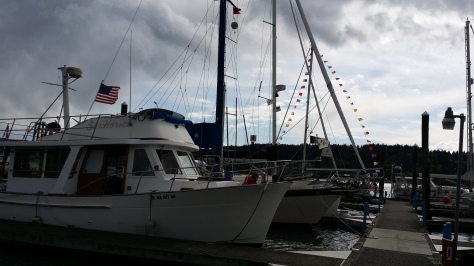
Poulsbo
The next morning we woke up to fog and glassy conditions.



There is a ton to do for everyone in Poulsbo. The bakery is great. The bookstores are great. There are great restaurants. There’s even a great little aquarium with free (donations) admission. In short, it’s a great destination.
My AIS presentation went well, I think. It’s difficult to find that right balance between technical and non-technical aspects in a presentation like this. Some of the geeky sailors wanted to know things like what kind of interface do the chips communicate on between the modules, while other sailors just picked up the Raspberry Pi and said “well that’s kinda cool” before putting it down. But in the end, I had lots of people that seemed legitimately interested, and very few people walked out of the room. Well, except my wife of course.
I also wanted to listen to the other presentations, and was able to catch the vast majority of all of them. We definitely need to do more cruising on our boat, even if it’s just short weekend trips. But to hear about the multiple-months-long trips that these sailors went on, and see some of the thousands of pictures they took was amazing. The room was mostly full the entire day.

Gramma and Papa took Tay and the dog home in the afternoon so that neither of them would be bored just sitting around. That night, with the boat to ourselves, we decided to watch the first episode of this season of Game of Thrones. About 20 minutes into the show, our electric heater went out. For those that have boats, you probably already know that electric heaters very often trip the breaker switch, and I assumed that was the situation here. Except when I looked at the switch panel, the breaker was fine. And the same was true with the breaker on the dock. For giggles I tried to turn over the engine, just to see… It barely made a sound. Uh-oh.
So at 11:00pm, I dug into the engine room with a headlamp. I grabbed my electrical meter, and stuck the probes on the first house bank — 13.7 volts. Then I tested each of the other house bank batteries, and all of them were fully charged. I tested the starter battery, though, and it registered only 9.8 volts — essentially dead!
We weren’t stuck because with the fully charged house bank I knew I could get the engine turned over if I wired the engine starter to it. It’s not the most efficient way to do it, but once would work just fine. But I needed to figure out why we ran down our starter battery while plugged in to shore power. As I’m tracing wires and trying to figure it out, I lift up one of the house bank batteries to see behind it… and a large cable falls away loose. It was stuck between the battery and the battery case, and I couldn’t see it. It was also about 8AWG, so substantially large. I reconnected it to the negative bus, and realized that it was the return line from the starter battery charge circuit — the starter wasn’t charging at all.
I believe that because our 1-2-All switch was set to all, we were running down both banks all weekend, and only the house bank was being replenished. After letting the starter battery charge overnight, the next morning I tested the engine and she turned over without hesitation. We were good to go again.
The Return Trip
Most of the boats were starting to leave around 10:00. After a couple cups of coffee, and failing to give away the last of our mini cinnamon rolls, we decided to follow suit. Running the Raspberry Pi Chartplotter (because why not?), we backed out of the slip we had rented, into a very wide fairway, spun the boat, and headed back south.
The return trip was, for the most part, uneventful. We saw more ferries coming through Rich Passage, and again had to deal with ferries leaving the Vashon Island docks that confused us (we thought they were going to head east, so moved out of the way of that direction, but instead the ferry turned 90 degrees and headed north, more towards us than away!), but there was nothing truly concerning.

The boat ran well the whole time, showing charging voltages on both battery banks, and we even took a short detour just north of Brown’s Point Lighthouse when we saw a small pod of Dall’s Porpoises off to our starboard.
Just four short hours after leaving the docks in Poulsbo, we were docking in our slip. Of course we did an absolutely terrible job on that docking maneuver! But at least there was nobody there to watch it happen, so nobody knows.
Right?
![m/v C:\[ESC]](https://mvcesc.files.wordpress.com/2018/05/cropped-headerbw.png)



















